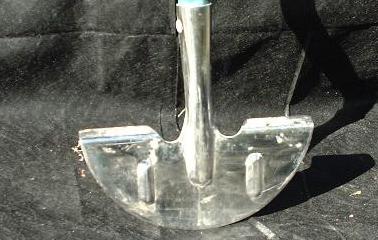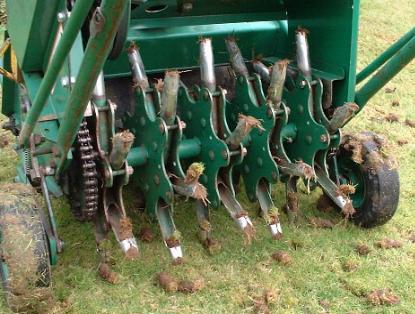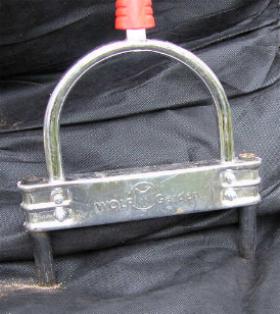Preparation Laying Turf Seed and Sowing Weeds and Pests Lawnmowers
Probably the most common reason for a poor quality lawn is lack of feeding. There are a number of lawn care specialist companies who offer a service to keep your grass in tip-top condition. This consists mainly of applying fertilizer three or four times during the year. By doing this the grass sward is kept dense and growing strongly, so moss and weeds have less opportunity to invade. The products used are widely available and relatively easy to apply.
Most of the lawn fertilizers for application during the growing season have a higher proportion of Nitrogen (N) than the other two major nutrients, Phosphate (P) and Potassium (K). This leads to relatively rapid growth and more frequent mowing. The latest innovation in lawn food has a roughly equal N:P:K proportion of 3:3:3, the lower Nitrogen and slightly higher level of Phosphate reduce the top growth and better root development respectively. To compensate for a possible reduction of the 'greening' effect of the Nitrogen, a small proportion of Iron is included; this would also have a moss-killing effect.
Regular applications of Seaweed fertiliser not only boosts the growth of the grass any excess which runs off the foliage helps to improve the health of the soil. As the concentration can vary between manufacturers it is best to follow instructions on the container to make up the solution which is applied with a sprayer.To keep the lawn in good condition it must also be cut regularly - at least once a week. If allowed to grow long, the coarser grasses will take over. This is often seen at the edges if they are not kept in trim; tufts of thick-bladed grasses appear and their rhizomes start to invade the flowerbeds. Also when longer grass is cut it suffers shock, becomes whitened and takes some time to recover. Only one third of the height should be removed at any time as reducing it too much deprives the grass of the ability to photosynthesise and support the needs of the remaining plant structure.
Frequent close cutting thickens the sward leaving no room for weeds to grow. The lowest height of the average lawn in summer, should be about 25mm (one inch). In spring, autumn and during drought periods the height should be about 33mm (1¼ inch).Irrigation is a contentious subject and in the present situation of water shortages and high water charging, watering the lawn is a luxury, but it does not need to be watered after it has been established. Too much irrigation causes the roots to remain close to the surface so they are unable to reach water lower down. Left to develop normally they will grow down further and are better able to withstand a dry spell. The first thing to do in dry weather is to allow the grass to grow longer, the deeper sward keeps the soil cooler so there is reduced loss by evaporation. If water is in extremely short supply, it should be kept for more important plants which do not recover. Even after apparently dying away much of the grass will recover and can easily be reseeded if necessary.
In drier regions the choice of grass species in the seed mix will have a great bearing on resistance to drought. White clover is sometimes included to maintain the green look, but it tends to be patchy and is slippery when wet.
If irrigation is necessary a good soaking once weekly is better than more frequent 'splashes' with a hose. The best time to water is in the evening so there will be less lost to evaporation and it has time to seep further down. To monitor the amount of water, place a container with vertical sides in the watering zone. When the water level has reached to about 2.5 cm the sprinkler can be turned off. This amount of water should percolate down to about 20 cm in normal soil (note the time taken for future waterings for setting a timer). Spiking will improve the penetration so more water can be stored lower down. 'Grey' water can be used for irrigation, this is water that has been used for washing or has been collected form the roof, but is not suitable for drinking. The choice of soaps and detergents is important and they should be biodegradable - the water from a dishwasher would not suit.A less formal grassed area can have some of the 'weed' grasses like Rye-grass, and a few broadleaved weeds are allowed as well. Cutting this 'utility lawn' too short will weaken the coarser grasses, allowing low growing weeds and moss to thrive. The frequency of mowing is every 5 to 7 days. From late spring the cutting height should be between 2.5 and 3 cm, in late autumn raise this to 3.75 cm until the following year. This gives it a better chance to resist the invasion of moss and weeds.
An important task not to miss is keeping the edges trimmed. Just by trimming the edges a lawn can appear to be newly mown. This may be left to alternate cutting times, but as mentioned above if they are not cut, coarser grasses thrive and encroach on the flowerbeds. Long-handled edging shears give the neatest finish. The way to use them is to hold the lower blade level and move the upper blade while sliding the shears sideways.
A half-moon lawn edger.
A half-moon edging tool is used to cut a clean face to the turf and this should remove any of the grasses spreading by rhizomes or stolons to invade the beds. This is usually done once per year.
When using a line trimmer to cut the edges care is needed if trees or shrubs are close by. Never allow the line to hit the trunk as this will damage the bark, and if the damage is severe it will kill the plant - trees and shrubs should have a grass-free area around them. Fence posts can also be damaged and if repeated the outer layer of treated timber will be worn away allowing the centre to rot (the preservative in pressure-treated timber only goes less than 1cm into the wood).There are some tasks which should be done less frequently to keep the sward in top condition. If the cuttings are removed it will require some feeding. As mentioned above, a common problem with a lawn is a lack of nutrients to keep it growing well and the weeds take over. The temptation is to starve the grass to reduce the need to mow as often, but this leads to more work to bring it back to health. (I know because I am guilty - it's a case of do as I say, not as I do!). Feeding is usually done as the grass starts into growth in the spring and again in the summer, with a final one in the autumn. The spring and summer feeds should contain more Nitrogen to encourage growth. The autumn feed should have a reduced Nitrogen content so that there is less soft leafy growth when frosts could cause damage. Also it can flop over in wet weather providing the conditions for fungal diseases like Snow Mould.
A layer of thatch which is made up of dead grass, moss and leaf debris, tends to build up choking the sward. This is more likely when a rotary mower is used due to the sweeping action of the blade. Removal is carried out by scarifying with a spring-tined rake or better still a rake with hardened tines made specifically for the job - the Wolf-Garten Roller Scarifying Rake has wheels which makes the job much easier. Small electrical and more powerful petrol-engined machines (below left) are more efficient for larger areas and can be hired since they are only required once a year. Quite reasonably-priced electrical models are available with interchangeable slotted discs or tines, but unless regularly used the collection box can be left off due to the volume of debris produced. Also if the task has not been carried out regularly the spring tines on electrical models may bounce along the surface and not penetrate to the base of the tight mat which has formed. The hardened tines of the Wolf rake or the slotted disks are better suited for this job.
Foot traffic and constant wetting and drying, compact the soil cutting off the air which is essential for healthy roots. Spiking is the remedy and involves inserting the tines of a fork to about 10 cm and gently levering back and forth. This also allows surface water to drain away more quickly. To keep the holes open, coarse sand can be swept across the surface, or a topdressing made up with sieved compost, sieved loam and coarse sand in the proportions 1:1:3 respectively. A plastic-tined leaf rake is ideal for combing it through the grass to leave the blades showing through; after a week and some rain or watering, the dressing will disappear. Some grass seed can be added to the dressing to improve the quality or if the grass is sparce.
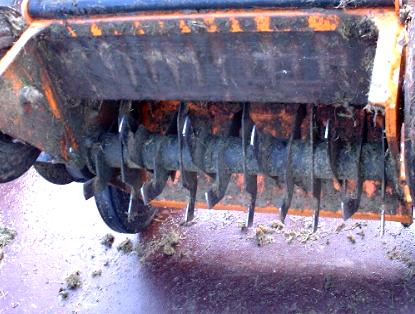
The picture on the left shows the tines of a mechanical scarifier; on the right, those of a hollow-tined aerator.For much better aeration and drainage, a hollow-tined aerator is used. The hand-operated version is a rectangular frame with four vertical tubes below a foot tread. The tubes remove a small core of soil about 1.5cm across and leaves a hole about 7.5 cm deep. When this is filled with coarse sand or grit the drainage is improved greatly. The mechanical version (above right) can be hired for larger areas, but is a bit of a beast.
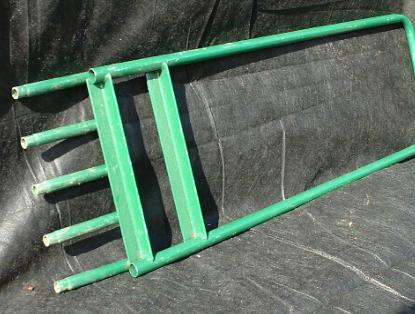
two manual, hollow-tined aeratorsScarifying and aerating are usually carried out in the autumn before the autumn feed, allowing time for the grass to recover before growth slows, but it can also be done in the spring. Professional greenkeepers use special biologically active liquid additives which stimulate microbial activity in the soil such as the mycorrhizal fungi that are associated with the grass roots. This can have a similar effect as adding fertilizer or aerating the soil so are useful when the ground is wet and mechanical methods cannot be used.
Grass Preparation Turf Seed and Sowing Lawnmowers Weeds and Pests
Back to Down Garden Services, or use the floating menu bar at the top of the page to find other garden-related articles (not visible in some browsers).
